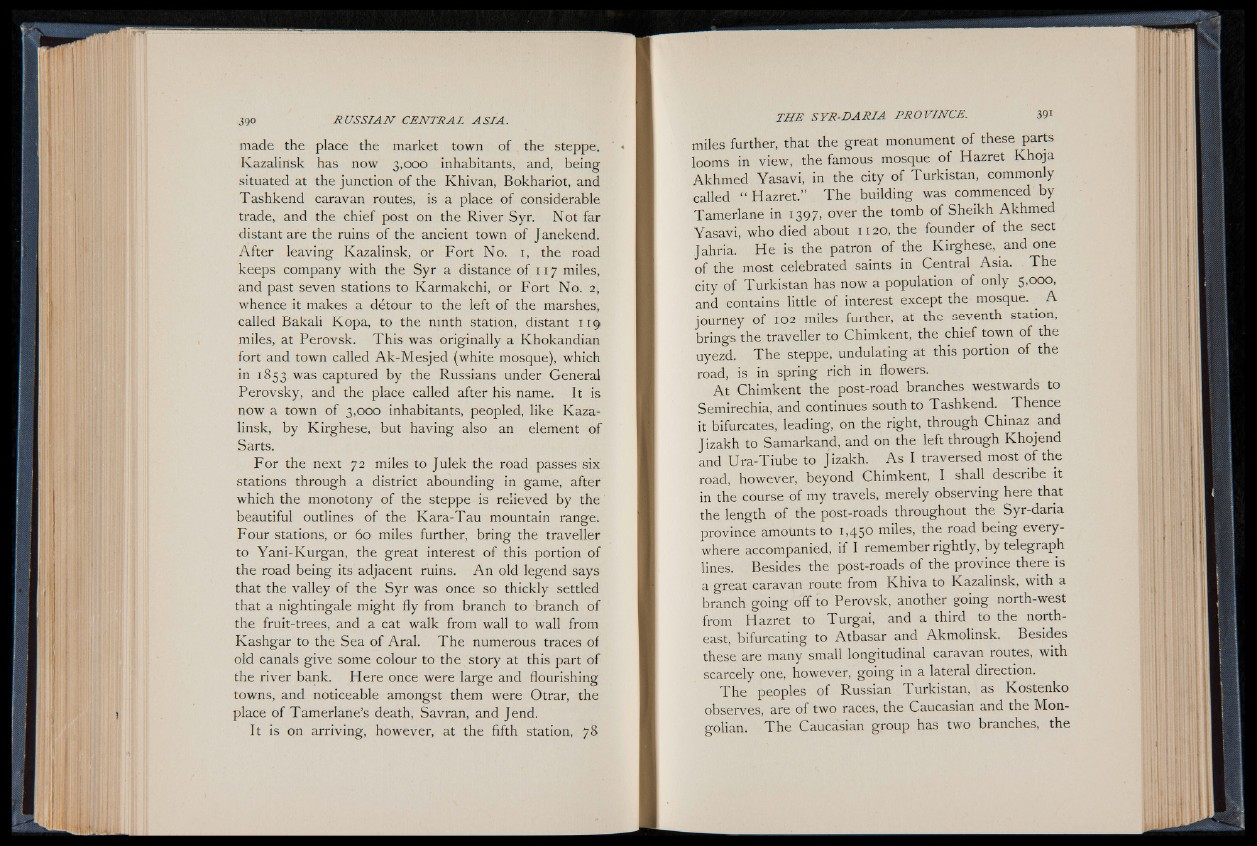
made the place the market town of the steppe.
Kazalirtsk has now 3,000 inhabitants, and, being
situated at the junction of the Khivan, Bokhariot, and
Tashkend caravan routes, is a place of considerable
trade, and the chief post on the River Syr. Not far
distant are the ruins of the ancient town of J anekend.
After leaving Kazalinsk, or Fort No. 1, the road
keeps company with the Syr a distance of 117 miles,
and past seven stations to Karmakchi, or Fort No. 2,
whence it makes a détour to the left of the marshes,
called Bakali Kopa, to the ninth station, distant 1x9
miles, at Perovsk. This was originally a Khokandian
fort and town called Ak-Mesjed (white mosque), which
in 1853 was captured by the Russians under General
Perovsky, and the place called after his name. It is
now a town of 3,000 inhabitants, peopled, like Kazalinsk,
by Kirghese, but having also an element of
Sarts.
For the next 72 miles to Julek the road passes six
stations through a district abounding in game, after
which the monotony of the steppe is relieved by the
beautiful outlines of the Kara-Tau mountain range.
Four stations, or 60 miles further, bring the traveller
to Yani-Kurgan, the great interest of this portion of
the road being its adjacent ruins. An old legend says
that the valley of the Syr was once so thickly settled
that a nightingale might fly from branch to branch of
the fruit-trees, and a cat walk from wall to wall from
Kashgar to the Sea of Aral. The numerous traces of
old canals give some colour to the story at this part of
the river bank. Here once were large and flourishing
towns, and noticeable amongst them were Otrar, the
place of Tamerlane’s death, Savran, and Jend.
It is on arriving, however, at the fifth station, 78
miles further, that the great monument of these parts
looms in view, the famous mosque of Hazret Khoja
Akhmed Yasavi, in the city of Turkistan, commonly
called “ Hazret.” The building was commenced by
Tamerlane in 1397, over the tomb of Sheikh Akhmed
Yasavi, who died about 1120, the founder of the sect
Jahria. He is the patron of the Kirghese, ^ and one
of the most celebrated saints in Central Asia. The
city of Turkistan has now a population of only 5,000,
and contains little of interest except the mosque. A
journey of 102 miles further, at the seventh station,
brings the traveller to Chimkent, the chief town of the
uyezd. The steppe, undulating at this portion of the
road, is in spring rich in flowers.
A t Chimkent the post-road branches westwards to
Semirechia, and continues south to Tashkend. Thence
it bifurcates, leading, on the right, through Chinaz and
Jizakh to Samarkand, and on the left through Khojend
and Ura-Tiube to Jizakh. As I traversed most of the
road, however, beyond Chimkent, I shall describe it
in the course of my travels, merely observing here that
the length of the post-roads throughout the Syr-daria
province amounts to 1,450 miles, the road being everywhere
accompanied, if I remember rightly, by telegraph
lines. Besides the post-roads of the province there is
a. great caravan route from Khiva to Kazalinsk, with a
branch going off to Perovsk, another going north-west
from Hazret to Turgai, and a third to the northeast,
bifurcating to Atbasar and Akmolmsk. Besides
these are many small longitudinal caravan routes, with
scarcely one, however, going in a lateral direction.
The peoples of Russian Turkistan, as Kostenko
observes, are of two races, the Caucasian and the IVLon-
golian. The Caucasian group has two branches, the